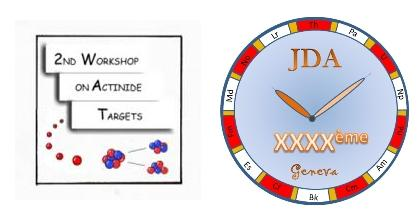Speaker
Mr
Dan Tiberiu Costin
(CEA)
Description
Actinides silicates, including coffinite (USiO4), and derived mineral phases obtained either by cationic or anionic substitutions have been widely studied from various points of view (chemistry, geology, radioecotoxicology). Even if some recent studies led to a reproducible method of preparation for synthetic coffinite samples, this family of compounds remains poorly described in terms of crystal structure. Moreover, in the way of an underground radwaste repository, the degradation of the confining barriers during an accidental situation could induce alteration phenomena. In such conditions, the interaction between actinides and the environment could lead to thermodynamic equilibrium controlling the concentration of actinides in solution, especially through the precipitation of neoformed phases such as coffinite and associated solid solutions. This study thus aims to investigate the formation of actinides bearing silicates, then to collect associated thermodynamic data, including solubility constants.
Several silicates of the zircon group MIVSiO4 (MIV = Zr, Hf, Ce, Si, Th, U) were then synthesized by both dry and wet chemistry methods. On the one hand, ZrSiO4 and HfSiO4 were obtained by mixing stoichiometric quantities of respectively ZrO2 and HfO2 with amorphous SiO2 (silica gel). The powdered mixtures were shaped into pellets and heated up to 1400° C for 24 hours. The pellets were then ground and analyzed by XRD (Fig. 1). The diffraction patterns revealed the formation of the silicate phases, respectively zircon and hafnon at 1400° C. Nevertheless, weak XRD lines of cubic MO2 were systematically observed and confirmed the formation of additional secondary phase.
Fig. 1 XRD powder pattern for the ZrSiO4 (left ) and HfSiO4 (right) samples.
On the other hand, the main protocol for wet syntheses of the silicates deals with the hydrothermal route developed by V. Pointeau et al. [1] after the method used by L.H. Fuchs and H.R. Hoetkstra in 1959, based on the principle that an insoluble metal silicate is usually precipitated as a gelatinous amorphous medium when a solution of a polyvalent metal salt is added to a solution of a soluble alkali metal silicate [2]. ThSiO4 was then prepared by adding drop wise thorium nitrate solution to sodium silicate solution in the expected stoichiomerty and adjusting the pH value to 10 using concentrated sodium hydroxide solution. The resulting gel was heated at 200° C for 20h. After cooling, the solution was centrifuged and the precipitate was separated, washed, dried than analyzed by XRD, SEM as well as IR and -Raman spectroscopies. The XRD powder pattern (Fig.2) clearly evidences the formation of ThSiO4 while SEM micrographs show a homogeneous phase composed by nanocrystals 20 nm in lenght. (Fig.2)
Fig. 2 XRD diagram and SEM observation of ThSiO4 obtained through hydrothermal synthesis.
Complementary studies are now performed to obtain USiO4 following the same protocol, with the exception that all the reactants will be outgased and the synthesis will take place in inert atmosphere (glove box) to avoid the oxidation of tetravalent uranium into uranyl.
References
1. V. Pointeau, A.P Deditius: Synthesis and characterization of coffinite: Journal of Nuclear Materials 393 ( 2009) 449-458
2. L.H. Fuchs, H. R. Hoekstra: The preparation and prorieties of uranium(IV) silicate: The American Mineralogist 44 1057-1063 1959
Primary author
Mr
Dan Tiberiu Costin
(CEA)




